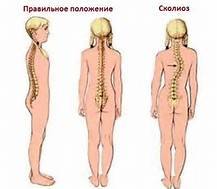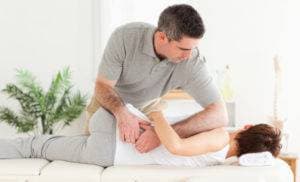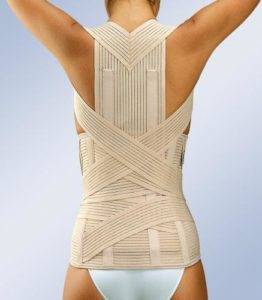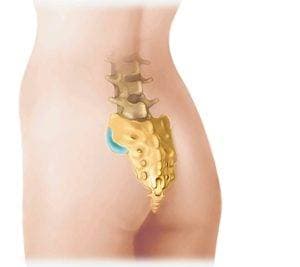Together with the change in the position of the spine under scoliosis, one understands the general curvature of the human body. The scapula on the right or left side protrudes more than the other, one shoulder becomes noticeably higher than the other.
You can notice the curvature of the body if you ask the person to lean forward a little. It is important to distinguish scoliosis and stoop. These are completely different medical terms and diseases. Scoliosis is the process of curving the spinal column with respect to its own axis in the right or left side.
Scoliosis affects the thoracic or lumbar spine. Causes that led to the emergence of scoliosis of the spine in children and adults, allocate a lot.
Symptoms of the disease
Symptoms of scoliosis are manifested both in external apparent disruption of the spinal column, and in poor health of the person, diseases and improper operation of internal organs:
- asymmetrical arrangement of the shoulder blades, elbows, shoulders and pelvis;
- broken gait;
- the curved position of the spinal column at different angles at one or several sites with respect to the central axis;
- regular pain in the back, chest and waist, in the area of scapula;
- headache;
- impossibility to perform physical work or stay in one position for a long time;
- deformation of the chest. It looks concave on one side, and convex on the other;
- diseases of the cardiovascular system;
- diseases of the central nervous system;
- lung diseases;
- diseases of the gastrointestinal tract.

The diagnosis can be made only after a comprehensive examination of the patient. It is necessary to have x-ray pictures of the spine in different angles.

The causes and danger of scoliosis
At the initial stage, scoliosis does not produce significant unpleasant sensations. Sometimes a patient may not suspect that he has a disease. The launched scoliosis, which was not subjected to competent treatment, affects the work of virtually all vital systems and human organs.
Scoliosis of the cervical part becomes the cause of cerebral circulatory disorders, the vertebral artery is compressed, as a result, there is a headache, dizziness, motion sickness, tinnitus, visual impairment. Scoliosis of the thoracic spine significantly reduces the working volume of the chest, abdominal cavity. As a consequence, due to incorrect location, the heart, lungs, stomach, intestines, liver and kidneys, vessels are malfunctioning.
Dysplastic scoliosis of the spine becomes the cause of hernia, osteochondrosis. Children with such a diagnosis quickly become tired. For women, dysplastic scoliosis can lead to infertility, problems with bearing and childbirth.
There is a scoliosis of the lumbar region – it does not allow the pelvic bones to occupy a normal location. The organs of the reproductive system, kidneys, and bladder are affected.
An effective remedy for pain and for the treatment of joints has been found:
- natural composition,
- without side effects,
- effectiveness, proven by experts,
- quick result.
Causes and factors of the disease
Today, in 8 out of 10 cases, doctors diagnose “idiopathic scoliosis” when the cause of its occurrence is not exactly known.
In other cases, scoliosis occurs due to the following factors:
- passive lifestyle;
- a man does not follow his posture, he constantly stoops;
- congenital disorders of the spinal column;
- rickets;
- polio;
- metabolic disease;
- diseases of intervertebral discs and connective tissues;
- osteoporosis;
- a deficiency of calcium in the body, which leads to improper development of bone tissue in childhood;
- dystrophy of the muscles of the lumbar, cervical and thoracic parts;
- suffered spinal trauma in children and adults (fractures, bruises, dislocations);
- tumor;
- suffered injuries of the pelvic bones and legs;
- myositis;
- congenital or acquired difference in leg length;
- Cerebral palsy;
- osteomyelitis, which led to deformation of the vertebrae;
- muscular contracture.
Children at risk of getting scoliosis from primary school to adolescence, when the skeleton is subject to constant growth and change

If we add to this an underdeveloped muscle tissue supporting the bones, then the probability of scoliosis increases dramatically. This is especially true for girls in their teens. Therefore, it is so important, from an early age, to teach the child to watch his posture, and also to engage in physical activity, to give his muscular and skeleton skeleton loads to strengthen, thus excluding the causes of this difficult to treat disease. Malnutrition also becomes one of the causes of the diagnosis – “scoliosis” in adolescent children.
There is a scoliosis today in different age groups of patients. Forms and types of curvature of the spine in children and adults there is a lot. A detailed classification of scoliosis is necessary for a specialist to more accurately diagnose and prescribe an effective treatment for each case.
By type of appearance, scoliosis is divided into:
Congenital scoliosis in children – appears in a person during its intrauterine development and is characterized by a violation in the development of the skeleton, cartilage and intervertebral discs. Diagnosis of the disease can be from the age of 7 years of the child. It is at this time that its obvious signs manifest. The vertebral column has abnormal abnormalities in the lumbosacral spine. This zone undergoes ossification in early childhood. Outwardly the child looks too thin, with underdeveloped musculature, has an oval-curved shape of the back. There is a violation in the development of the human nervous system, because of which the child develops poorly, there is a certain degree of backwardness, in the absence of treatment, the disease leads to serious disorders of the nervous system. The limbs of a person with congenital scoliosis are always cold, there is increased sweating.
Acquired scoliosis – is formed in a healthy person under the influence of unfavorable environmental factors. It appears as a result of a spinal column injury, because of the underdeveloped muscular corset of the spinal cord, the body of a person in the wrong position from childhood.
In turn, the availability of acquired scoliosis in adolescents is divided into the following types:
- Rachytic scoliosis – has an early onset. The diagnosis can be made already in school-age children. Deformation of the spine is usually observed around 9-12 thoracic vertebrae;
- idiopathic is the most common type of disease, when the causes of scoliosis in children are not fully known. It also has an early development, it can be diagnosed in 4-6 years;
- paralytic scoliosis – is a consequence of a disease such as poliomyelitis. This type of scoliosis is characterized by the rapidity of progressive symptoms. The spine becomes mobile, the muscle corset is too weak, the thorax is deformed. The rib hump is forming. The gait of a person changes because of the weakening of the gluteus muscle;
- primary scoliosis is the kind of disease that is formed in children of school age under the influence of unfavorable environmental factors. The cause of scoliosis in children – too heavy and uncomfortable satchel, a long stay in an uncomfortable position;
- ishialgic scoliosis – is the consequence of a severe form of sciatica, the curvature occurs in the opposite direction from the affected area;
- static scoliosis – is the cause of the transferred injuries or diseases (tuberculosis of bones, flat feet). The focus of the disease is most often in the lumbar spine.
Above are the most common types of acquired scoliosis. The more rare cases arise as a result of improperly fused spine parts as a result of a fracture, as well as other pathologies.
- Depending on the geometric shape of the curvature, scoliosis is distinguished:C-shaped, which has violations along one arc;
- S-shaped, which is characterized by a violation of two arcs;
- Z-shaped, which is characterized by a curvature along three sections (arcs).
Depending on the location of the curvature, scoliosis is divided into cervical, thoracic, cervicothoracic, lumbar-thoracic, lumbar and combined forms.Scoliosis is classified into the following types, depending on the degree of curvature of the spinal column:1-st degree, when the curvature of the spine is practically not visible with the naked eye.
The diagnosis can be made only on the basis of X-rays taken in different projections. Usually the degree of deviation of the spine from the central axis is no more than 10 degrees.
- The 2nd degree of curvature is already visible to the naked eye. In this case, one scapula protrudes over the entire surface of the back, one shoulder is located above the other, and on X-ray images it is seen that the angle of deviation of the spine from its normal position is 25 degrees.
- The third degree is characterized not only by the spinal column, but also by the internal organs. Visually, you can see a pronounced rib hump. The motor activity of a person is sharply reduced, he suffers from cardiac and pulmonary dyspnea due to improper placement of internal organs, severe sweating and general weakness of the body. On X-ray images, the angle of deviation of the spine from its normal lesion is not more than 40 degrees.
- The 4th degree of scoliosis is expressed so much that the twisted spine is noticeable even in a person in clothing. In x-ray examination, the angle of deviation of the spinal column from the central one is 50 degrees. Visually, the trunk becomes short, and the limbs are elongated, the thorax becomes arched. Violated the work of virtually all internal organs and systems. The patient suffers from edema, has a degree of disability and needs regular medical care.
Treatment of scoliosis
Ways to get rid of a person from the curvature of the spine can be divided into the following types.Conservative methods involve the use of traditional methods: exercise therapy, manual therapy, massage, sanatorium treatment. The goal of the conservative method is to achieve such a position of the spine, in which the effect of scoliosis will be minimal, there will be a stable remission of the disease.

The principle of conservative treatment consists of the following steps:
- elimination of unfavorable factors leading to an incorrect arrangement of vertebral discs;
- development of muscle activity;
- complexity and consistency of treatment, systematic and consolidating the results;
- treatment of internal organs affected by their improper location;
- debugging of the achieved result at the level of brain impulses.
Surgical methods are rather controversial among doctors. There are a number of indisputable indices, according to which the only way to treat scoliosis is surgical intervention:curvature of the spine from 50 degrees. Over time, without treatment, deformation will increase, squeezing internal organs and disrupting their work;
deformation of the spine with a deviation of 40 degrees and with a progressive form. This especially applies to children and adolescents, when the body is in a stage of active growth;
defeat of the spinal cord with accompanying neurological disorders, accompanied by pain.
Orthopedic methods or orthotics involves correction of the curvature of the spine with the wearing of a corset, which helps restore the natural position, and also maintains muscle tone in the lumbar region.

Prostheses are of different types depending on the degree of scoliosis. So one is shown wearing for 2-4 hours a day. Their goal – corrective, so the effectiveness of their application is indicated in scoliosis at its initial stage.
Other corsets have a more rigid base and are shown for wearing for 6 hours a day with scoliosis 1-2 degrees.
In the presence of scoliosis of the third degree, wearing a corset lasts from 6 hours a day and can last throughout the day, as well as at night. But with a strong curvature of the spine, orthopedic methods are rarely used. It also shows the treatment of surgical intervention, since it is about the health of internal organs and systems of the human body.
In the fight against scoliosis, one should not forget about the conduct of a healthy lifestyle. An important place in it is given to physiotherapy exercises, which a person can do at home on his own, and by attending specialized classes. During exercise exercises, the muscular corset of the skeleton will be trained, and scoliosis will gradually begin to be corrected. So, physical therapy helps to get rid of scoliosis 1 and 2 degrees, especially for children and adolescents with a growing body. With disease of 3 and 4 degree there is a stop of progressive development of the disease, due to the formation of a strong muscular corset, which takes on some of the loads from the curved spine.
Scoliosis is a disease, the disposal of which lasts from several months to several years, thanks to hard work and observance of all the prescriptions of the attending physician. The success of treatment and the prevention of disease depend not only on the chosen technique, but also on the patient’s desire and perseverance. It is also important to find out the reasons and direct all efforts to eliminate them.



